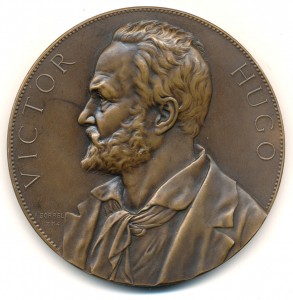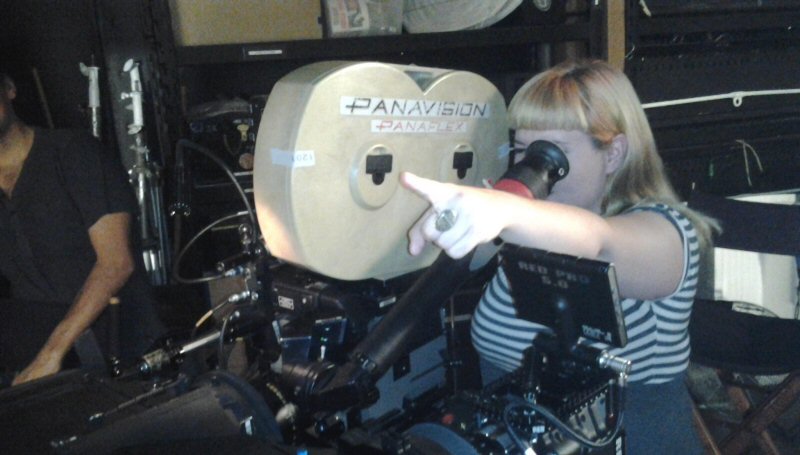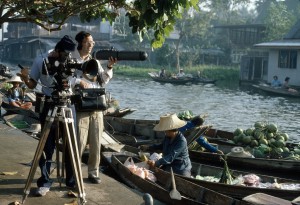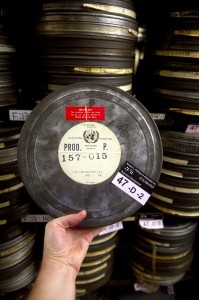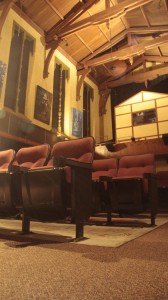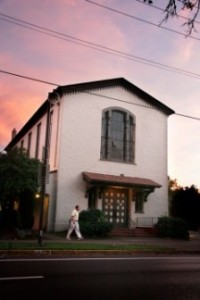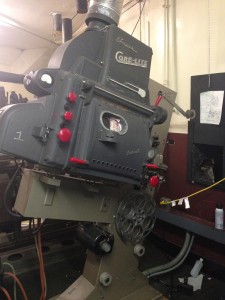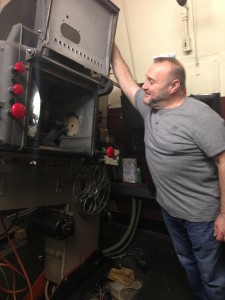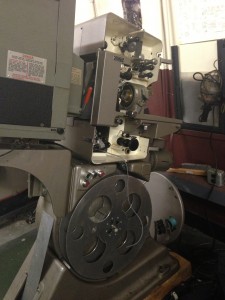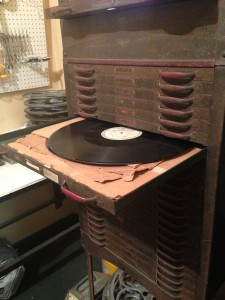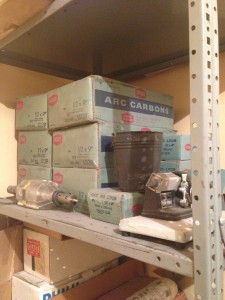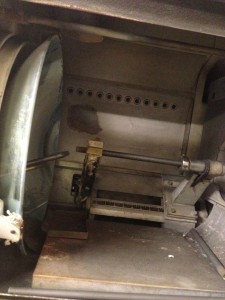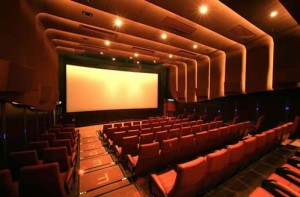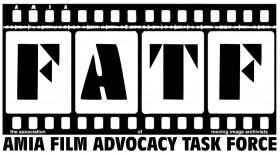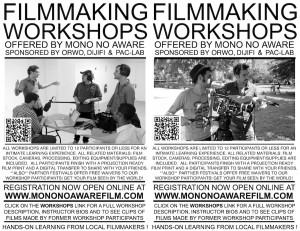
Amid the chaotic buzz of commercial transactions at a downtown grocery, MONO NO AWARE’s Steve Cossman took a rare free moment to speak with Tara D. Kelley about the organization’s history, current trajectory, and that whole ‘future of film’ thing. With MONO NO AWARE VII, an astonishing slate of fall workshops, and the collective’s low-cost film equipment rental program all swiftly approaching, this is a very exciting time to engage with film and with MONO NO AWARE.
MONO NO AWARE (‘moh-no no ah-wah-ray’): people will ask, “what does that mean and why did the collective choose this name?”
MONO NO AWARE began as a solo effort and naturally grew into a collective organization. I moved to New York in 2006, I had just returned from film school and I was looking for a way to engage with the local film community. I spent 2 years in Prague studying film production with a focus on stop-motion puppet animation. While there, I was re-introduced to avant-garde, experimental cinema, and various forms of the moving image throughout history. Previously, I had taken a few film courses, but my background was primarily in sculpture: I had done metalwork for years. It was my experience in Prague which pushed my practice and thinking towards time-based art.
I thought a good way for me to get engaged with the community would be to organize some sort of exhibition or festival. I had seen a lot of festivals – thousands of festivals, actually – listed everywhere for every genre and subgenre and micro-genre – on T-shirts, tote bags, and posters. I set out to do something that was unique and meaningful. I wanted to focus on what drew me to cinema in the first place.You know, that gathering of strangers sharing this common experience; responding orally, laughing together, or being in shock. There is a kind of magic that happens there that I felt was missing with previous gallery exhibitions. I really wanted to do something where it was about that gathering, where the emphasis was on that cinematic experience. So, the initial idea for MONO NO AWARE, the exhibition, was: expanded cinema performance, with projected film prints only, to kind of over-emphasize that idea of the artist being present, the audience being present, and the work being a one-time experience…
…which kind of leads into the concept of Mono no aware, the Japanese expression having to do with this emotional connection with something that’s fleeting and this attraction to the ephemeral. The environment created by expanded cinema performance, or even by an installation which has that moving image element, is kind of this temporal experience. The group of people that you share it with is unique in that sense, too, so… It seemed to fit the event.
MONO NO AWARE started with just me organizing the festival the first three years. From there, with the help of friends, it’s built into a dynamic arts organization with educational initiatives, monthly screenings and everything that it’s become today.
Did that start organically from the first experiences at the festival? Were people approaching you afterward, or did you approach other filmmakers to become involved and contribute?
I had never run a festival – I had really never run a business before – and I went about this very systematically. I called universities with film departments that were still shooting on film. I spoke with the head of each department and said, “Hello there, this is what I’m trying to do. If you have students or colleagues interested, please let me know.” I wrote letters with a call for entries to museums that I knew had a history of showing this kind of work, or who had a good relationship with their own local film community.
Thankfully, people responded very positively. Actually, I was very nervous the first year. I thought no one was going to show up! It turned out the event was over capacity on a Sunday night at the old Galapagos Art Space on North 6th. At the end of the night, someone said to me “this was so great, you really need to do it again.” Originally I had thought I was just going to do it once, but it became ‘a thing’.
After about three years of organizing the festival, that’s when a community began to form. People were starting to ask more questions, wanting to get involved. Initially, workshops were offered out of my living room, using my bathroom as a darkroom and we had 30 participants. Now we see 200 participants in a year and that number keeps growing.
I want to make sure people are enrolling for workshops and making you even more busy. What’s coming up that you’re super excited about?
What I’m excited about are all the workshops we’re offering this fall. Handmade Emulsion Workshop: making your own emulsion. We’ll be offering the Alternative Processing Techniques Workshop again, which is incredibly interesting: mixing your own chemistry, learning about tinting and toning, doing E6, C41, D19, the whole range of developers. Also, we’ll be offering Super 8 on Color Reversal [Film], Kodak’s Ektachrome 100D. We have some of the last stock, so I’m super excited to have the students shoot on color reversal and project on color reversal Super 8. And, you know, the 100D is just beautiful projected.
Also, on September 7th, we’ll be taking a field trip to the Thomas Edison Museum to see the replica of the Black Maria. I’m excited about the whole thing: I’ve rented a yellow school bus and we’ve got bagged lunches set up with Urban Rustic. I think it’s going to be a lot of fun!
Then our call for [MONO NO AWARE VII] entries, the deadline is October 31st. We’ve already got almost fifty entries at this point, which is so early for us to have this much. We’re seeing a lot of work coming out of Mexico and South America, which is super exciting. We are getting stuff from France, and a couple entries from Korea. It’s thrilling to receive a lot more international entries, and the range of work is really starting to diversify from expanded cinema to truly what we’d like it to be, which is; the moving image on film in any shape or form of art, performance and sculpture.
When I hear that people are submitting work from Mexico and South America and Korea and France, I get excited because these are people creating film on film. So I’ll ask you – because you’re making films, you’re out there meeting other filmmakers, you’re teaching workshops and classes that seem to be filling up really quickly – what is your sense of the future of film?
I don’t know if I’m really qualified to answer that! (laughter) I’m as much in the hands of the material and the manufacturers as anybody else. I certainly can’t single-handedly change anything and as an organization we can certainly make a small dent in sales for these companies, but we really can’t start a revolution – we need to work together. It’s a strange situation, because if they stop making oils, painters use acryllic or guache or mix berries if they are desperate. They have options. But, in the case of working on film, if Kodak stops making film, there are very few other people making it. That’s why we’re really, really excited about our partnership with ORWO. They’ve been extremely supportive and seem to understand that film is a special material, that it’s not just a product. There is a community behind it and there is something special and unique and worth preserving about this medium – and, that there are makers who are dedicated and who are loyal to it.
The future of film is uncertain. I have a sense of why people are excited about it again, which I think – might be attributed to so many things becoming automatic. There are filters and applications that, at the push of a button, create a sepia tone effect or a solarizing effect or anime-eyes effect – but it’s all binary and the results are still encoded. There’s no room for accidents and experimentation, and there’s no room for things to be out of control. It’s kind of this idea of losing the sense of wilderness. Forests and jungles becoming smaller and smaller, and we miss the unknown. For me, it’s something innate that I’m drawn to the chaos in nature. I mean, I don’t want to say ‘I love chaos’ — but it’s good when things are a little bit out of control, right?
Is there anything you want to share about where MONO NO AWARE will go next?
[MONO NO AWARE Assistant Director] Sean Hanley and I have spent the last two months going through our personal and collective equipment to develop a rentals program. There will soon be a section of the MONO NO AWARE website that will allow anyone in New York, especially our former students, to continue their practice on film with reliable, accessible, and affordable film equipment. We’ve got Super 8mm cameras, 16mm cameras, an ARRI kit, projectors and screens. We will also have Steenbecks and editing set-ups available hourly, film stocks and editing supplies. I want to say this will be ready in October, but don’t hold me to that! (laughter) By the end of the year, we’ll have a full service rentals program.
My goal for 2014 is to have a week-long filmmaking retreat. I’m scouting spaces in upstate New York, Long Island, Pennsylvania and Canada to set up a base-camp for workshops and screenings; an escape from New York with the opportunity to totally separate oneself from the busy city life to focus on creating work on film. MONO NO AWARE is lucky enough to have local workshop participants give us two hours a night, three or four nights in a month, and we’re always blown away by the incredible work they make. As we improve on the workshop experience the films made in them grows in tandem. I’d really like to take our local offerings to another level with this retreat – foster and develop skills, giving participants the chance to experiment and think about form/content. Again, always continuing to make it affordable.
Also, this year I had the fortunate experience of meeting a very curious and extremely talented nine-year-old* – If I can find the time I would like to engage more with the younger audience. I feel like people who take our workshops are familiar with the formats and the technology and even though for some of the younger participants it may seem antiquated or have this certain nostalgic appeal, for the younger people, it’s not even on the radar.
They don’t have the history.
They don’t have the history, only because their exposure has been limited. One of my first jobs out of college was teaching art at a Montessori school and I think that it would be great to work with children to show them what it means to have that film experience. I welcome the chance to educate and share with them that film is still an option if they have interest in the moving image.
Sometimes I’ll be shooting with my Bolex, and people will say “Those things are so hard to find!” or “Too bad you can’t get projectors anymore” or “The parts are going to be harder to come by, and soon you’re not going to be able to shoot anymore.” So much of which is a misconception, it’s no wonder film is foreign to so many children and young adults. I feel like we’re at a point where the common person believes that digital and technologies have replaced analog machinery all together. My response to that is, ‘Have you seen what a 3D printer can do?’ At some point, I’m going to be able to 3D scan my entire Bolex and print out a Bolex then shoot film with it! I can replicate almost any EIKI part I need, I’m going to be able to build an optical printer in Rhino. I’ll be able to build custom gates and trick it out in any way I want. I think certain advancements in technology make it possible to sustain analog practices and improve upon them.
It hasn’t come to that point just yet. Right now, film equipment is more accessible than it’s ever been. So many schools and filmmakers are just unloading equipment. They’re either giving it away or selling it cheap – happy to see it put to ‘good use’. If, twenty years ago, you wanted to shoot on film you’d have a hard time affording to rent a camera, and certainly you wouldn’t buy one. Now, you might fall into one for less than a grand or possibly free. Equipment is collecting dust on closets and shelves, all you need is some simple maintenance to get it running again. How are you going to say that it’s difficult, or more expensive, to shoot on film when someone hands you a camera for free?
In your case, it’s raining equipment.
(Laughter) Well, not exactly, though kind supporters are beginning to call us to donate cameras, rewinds, splicers and films. Right now is the best time to be a filmmaker, for sure!
On that positive note: you can view student work from MONO NO AWARE workshops (*including nine-year-old Shane Fleming’s film, “ART”) on MONO NO AWARE’s Vimeo channel. – TDK
> PDF Version of this Article
